Jeep Cherokee (XJ): Description and operation
DESCRIPTION The clutch mechanism consists of a flywheel, a single,
dry-type disc, and a diaphragm style clutch cover
(Fig. 1). A hydraulic linkage is used to operate the
clutch release bearing and fork. The flywheel is
bolted to the rear flange of the crankshaft. The
clutch pressure plate is bolted to the flywheel with
the clutch disc located between these two components.
The clutch system provides the mechanical,
but still easily detachable, link between the engine
and the transmission. The system is designed to
ensure that the full torque output of the engine is
transfered to the transmission while isolating the
transmission from the engine firing pulses to minimize
concerns such as gear rattle. OPERATION Leverage, clamping force, and friction are what
make the clutch work. The disc serves as the friction
element and a diaphragm spring and pressure plate
provide the clamping force. The clutch pedal, hydraulic
linkage, release lever and bearing provide the
leverage.
The clutch master cylinder push rod is connected
to the clutch pedal. When the clutch pedal is
depressed, the slave cylinder is operated by the
clutch master cylinder mounted on the dash panel.
The release fork is actuated by the hydraulic slave
cylinder mounted on the transmission housing. The
release bearing is operated by a release fork pivoting
on a ball stud mounted in the transmission housing.
The release bearing then depresses the pressure
plate spring fingers, thereby releasing pressure on
the clutch disc and allowing the engine crankshaft to
spin independently of the transmission input shaft
(fig. 2).
1 - FLYWHEEL DESCRIPTION The flywheel (Fig. 3) is a heavy plate bolted to the
rear of the crankshaft. The flywheel incorporates the
ring gear around the outer circumference to mesh
with the starter to permit engine cranking. The rear
face of the flywheel serves as the driving member to
the clutch disc.
1 - CRANKSHAFT OPERATION The flywheel serves to dampen the engine firing
pulses. The heavy weight of the flywheel relative to
the rotating mass of the engine components serves to
stabilize the flow of power to the remainder of the
drivetrain. The crankshaft has the tendency to
attempt to speed up and slow down in response to
the cylinder firing pulses. The flywheel dampens
these impulses by absorbing energy when the crankshaft
speeds and releasing the energy back into the
system when the crankshaft slows down. DESCRIPTION The clutch disc friction material is riveted to the
disc hub (Fig. 4). The hub bore is splined for installation
on the transmission input shaft. The clutch disc
has cushion springs in the disc hub to dampen disc
vibrations during application and release of the clutch. OPERATION The clutch disc is held onto the surface of the flywheel
by the force exerted by the pressure plate's diaphragm
spring. The friction material of the clutch disc
then transfers the engine torque from the flywheel and
pressure plate to the input shaft of the transmission. DESCRIPTION The clutch pressure plate assembly is a diaphragm
type with a one-piece spring and multiple release fingers
(Fig. 5). The pressure plate release fingers are
preset during manufacture and are not adjustable.
The assembly also contains the cover, pressure plate,
and fulcrum components.
1 - FACING MATERIAL
1 - COVER OPERATION The clutch pressure plate assembly clamps the
clutch disc against the flywheel. When the release
bearing is depressed by the shift fork, the pressure
exerted on the clutch disc by the pressure plate
spring is decreased. As additional force is applied,
the bearing presses the diaphragm spring fingers
inward on the fulcrums. This action moves the pressure
plate rearward relieving clamp force on the disc.
The clutch disc is disengaged and freewheeling at
this point. DESCRIPTION A conventional release bearing (Fig. 6) is used to
engage and disengage the clutch pressure plate
assembly. The clutch release bearing is mounted on
the transmission front bearing retainer. The bearing
is attached to the release fork, which moves the bearing
into contact with the clutch cover diaphragm
spring.
1 - RELEASE BEARING OPERATION The release bearing is operated by a release fork in
the clutch housing. Slave cylinder force causes the
release lever to move the release bearing into contact
with the diaphragm spring. As additional force is
applied, the bearing presses the diaphragm spring
fingers inward on the fulcrums. This action moves
the pressure plate rearward relieving clamp force on
the disc. Releasing pedal pressure removes clutch
hydraulic pressure. The release bearing then moves
away from the diaphragm spring which allows the
pressure plate to exert clamping force on the clutch
disc. DESCRIPTION The hydraulic linkage consists of a clutch master
cylinder with integral reservoir, a clutch slave cylinder
and an interconnecting fluid line (Fig. 7).
The clutch master cylinder push rod is connected to
the clutch pedal. The slave cylinder push rod is connected
to the clutch release fork. The master cylinder is
mounted on the driver side of the dash panel adjacent
to the brake master cylinder and booster assembly.
1 - CAP OPERATION The clutch linkage uses hydraulic pressure to operate
the clutch. Depressing the clutch pedal develops
fluid pressure in the clutch master cylinder. This
pressure is transmitted to the slave cylinder through
a connecting line. In turn, the slave cylinder operates
the clutch release lever.
Slave cylinder force causes the release lever to
move the release bearing into contact with the diaphragm
spring. As additional force is applied, the
bearing presses the diaphragm spring fingers inward
on the fulcrums. This action moves the pressure
plate rearward relieving clamp force on the disc.Clutch
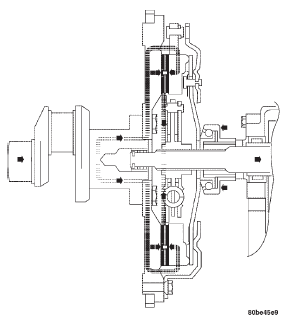
Fig. 1 Engine powerflow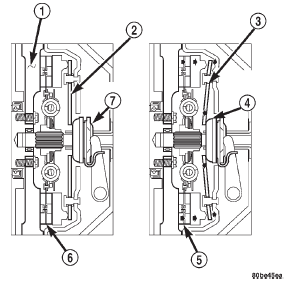
Fig. 2 Clutch Operation
2 - PRESSURE PLATE FINGERS
3 - PIVOT POINT
4 - RELEASE BEARING PUSHED IN
5 - CLUTCH DISC ENGAGED
6 - CLUTCH DISC ENGAGED
7 - RELEASE BEARINGFlywheel
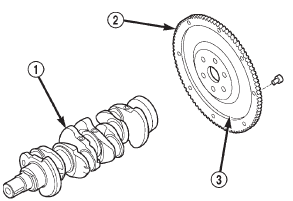
Fig. 3 Flywheel
2 - RING GEAR
3 - FLYWHEELClutch disc
Clutch pressure plate
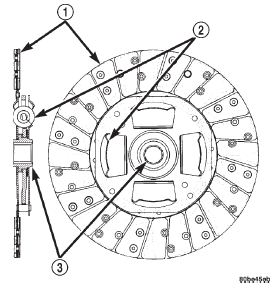
Fig. 4 Clutch Disc-Typical
2 - DAMPER SPRINGS
3 - HUB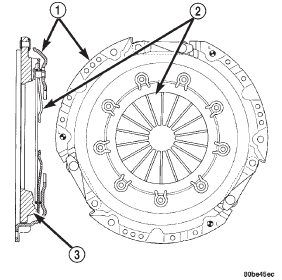
Fig. 5 Clutch Pressure Plate-Typical
2 - RELEASE FINGERS
3 - PRESSURE PLATEClutch release bearing
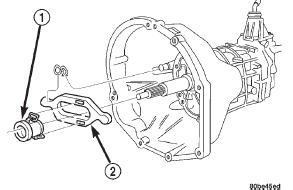
Fig. 6 Clutch Release Bearing
2 - RELEASE FORKHydraulic clutch linkage
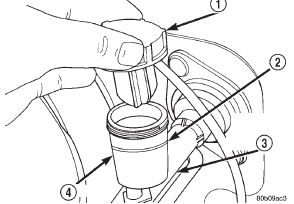
Fig. 7 Clutch Master Cylinder
2 - FILL LINE
3 - CLUTCH MASTER CYLINDER
4 - RESERVOIR
Other materials:
Oil pump. Overdrive planetary gear and
clutch. Overdrive support
Oil pump
DISASSEMBLY
(1) Remove pump body O-ring (Fig. 199).
(2) Remove pump seal.
(3) Remove pump seal rings (Fig. 199).
(4) Remove bolts attaching stator shaft to pump
body and separate components.
(5) Remove drive gear and driven gear from pump
body (Fig. 199).
Fig. 199 Oil Pu ...


